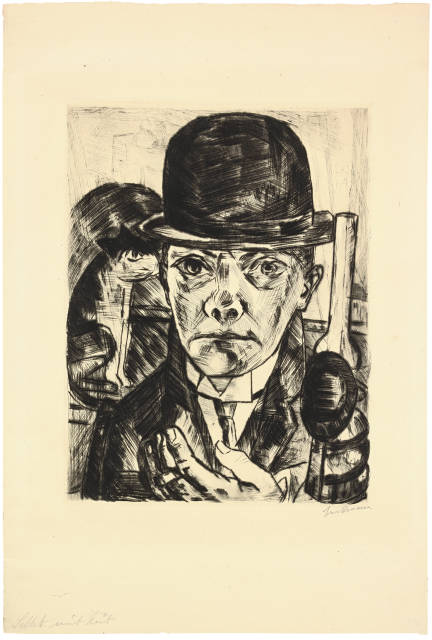- EN
Log in
- Live Auctions
- Past auctions
- More
- Gallery
- Art Dealing
- Publishing
- Kornfeld today
- The Story of Kornfeld
- Information



Sale time 12-09-2024,
about 09:40 h (CET)
(+/- 30 min)
1921
Drypoint on laid paper
31.5x24.7 cm, plate edge; 50x33.5 cm, sheet size
Signed "Beckmann" by the artist in pencil lower right, inscribed "Selbst mit Hut" in the lower left margin
Hofmaier 180/III/A (of IV/B)
The Eberhard W. Kornfeld Collection, Bern, with the collector's stamp on the reverse, Lugt 913b
Basel/Hovikodden 1975/1977, Kunstmuseum/Henie-Onstad Kunstsenter, Masterpieces of Graphic Art from 1800 to the Present, cat. no. 203
Salzburg/Winterthur 1984/1985, Rupertinum/Kunstmuseum, Von Goya bis Warhol, Meisterwerke der Graphik des 19. und 20. Jahrhunderts aus einer Schweizer Privatsammlung [Slg. Eberhard W. Kornfeld], cat. no. 179
Riehen 2003, Fondation Beyeler, Expressive!, p. 188, ill. p. 120
Slight undulation in the paper upper left. Minimal soiling to the outer sheet edges. In very good condition
Max Beckmann captured himself in many self-portraits. Unlike many of his fellow artists, he usually portrayed himself "officially" or even as a painter prince. From 1915, Beckmann stayed in Frankfurt with his friends, the Battenbergs, in order to recover from the experiences of the First World War. From 1918 onwards, the tomcat "Pummi", who can also be seen to the left of the artist in the present print, continued to appear as an assistant figure.
The "Selbstbildnis mit steifem Hut", made in Frankfurt in 1921, is considered the most expressive and important self-portrait in the artist's graphic oeuvre and is a milestone in the entire German graphic production of the first half of the 20th century.
Beckmann's self-portraits are always a testimony to his current situation in life. However, he was never concerned with mere reproduction; Beckmann always turned his gaze inwards, creating an impressive inventory of his inner self. Here, too, the painter looks confidently out of the picture space.
Despite the presumed edition of around 50 copies, prints are very rare on the market, and it is questionable whether the number of copies, which Hofmaier questions, is actually correct. Hofmaier is aware of five proofs of the third state. Both the third and the fourth state were published in editions, but both without numbering. In J. B. Neumann's publishing catalogue of 1922, Graphik von Beckmann 1911-1922, the print appears at Mk. 5000, by far the highest estimate. Copies of such excellent quality are very rare.
1921
Kaltnadel auf Bütten
31,5x24,7 cm, Plattenkante; 50x33,5 cm, Blattgrösse
Unten rechts vom Künstler in Bleistift signiert "Beckmann", im Unterrand links bezeichnet "Selbst mit Hut"
Hofmaier 180/III/A (v. IV/B)
Slg. Eberhard W. Kornfeld, Bern, rückseitig mit dem Sammlerstempel, Lugt 913b
Basel/Hovikodden 1975/1977, Kunstmuseum/Henie-Onstad Kunstsenter, Meisterwerke der Graphik von 1800 bis zur Gegenwart,
Salzburg/Winterthur 1984/1985, Rupertinum/Kunstmuseum, Von Goya bis Warhol, Meisterwerke der Graphik des 19. und 20. Jahrhunderts aus einer Schweizer Privatsammlung [Slg. Eberhard W. Kornfeld],
Riehen 2003, Fondation Beyeler, Expressiv!,
Oben links leichte Wellen im Papier. Minime Verschmutzungen an den äusseren Blattkanten. In guter Erhaltung
Max Beckmann hat sich in vielen Selbstbildnissen festgehalten. Anders als viele Künstlerkollegen stellte er sich meistens "offiziell" oder gar als Malerfürst dar. Ab 1915 hielt sich Beckmann in Frankfurt bei seinen Freunden, dem Ehepaar Battenberg, auf, um sich von den Erlebnissen des Ersten Weltkrieges zu erholen. Ab 1918 taucht als Assistenzfigur immer wieder der Kater "Pummi" auf, der auch im vorliegenden Blatt links neben dem Künstler zu sehen ist.
Das 1921 in Frankfurt entstandene "Selbstbildnis mit steifem Hut" gilt als das ausdrucksstärkste und wichtigste Selbstbildnis im graphischen Œuvre des Künstlers und ist ein Meilenstein in der gesamten deutschen Graphikproduktion der ersten Hälfte des 20. Jahrhunderts.
Beckmanns Selbstporträts sind immer auch Zeugnisse seiner jeweiligen Lebenssituation. Es geht ihm jedoch nie um eine reine Wiedergabe, stets lenkt Beckmann den Blick in die Tiefe und schafft so eindrücklich eine Bestandesaufnahme des Inneren. Auch hier blickt der Maler selbstbewusst aus dem Bildraum.
Trotz der vermuteten Auflage von ca. 50 Exemplaren kommen Drucke nur sehr selten im Handel vor, und es ist fraglich, ob die auch von Hofmaier in Frage gestellte Auflagenhöhe tatsächlich stimmt. Vom III. Zustand sind Hofmaier 5 Probedrucke bekannt. Sowohl der III. wie der IV. Zustand wurden in Auflagen publiziert, beide jedoch ohne Nummerierung. Im Verlagsverzeichnis von J. B. Neumann von 1922, Graphik von Beckmann 1911-1922, erscheint das Blatt mit Mk. 5000.-, mit dem weitaus höchsten Ansatz. Exemplare in so vorzüglicher Qualität sind sehr selten.
| Switzerland | CHF | 130 |
| Europe | CHF | 230 |
| Overseas | CHF | 290 |




